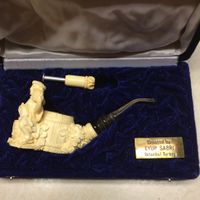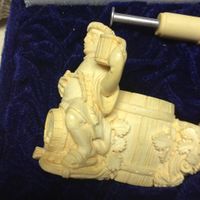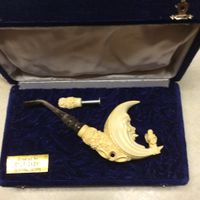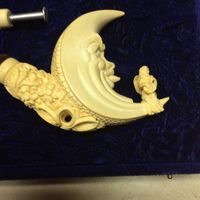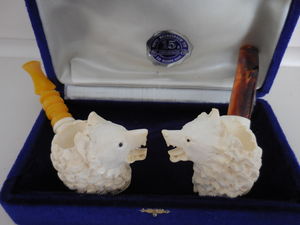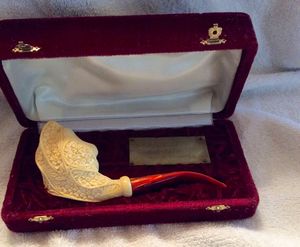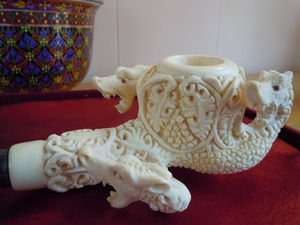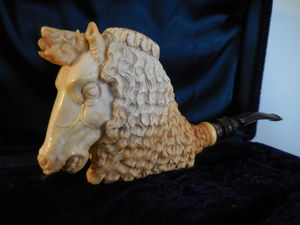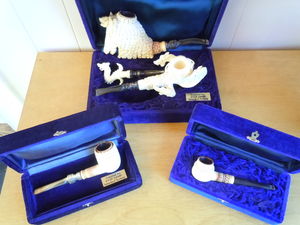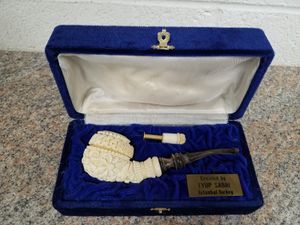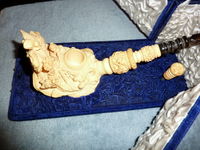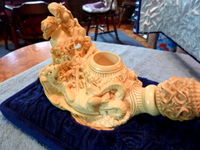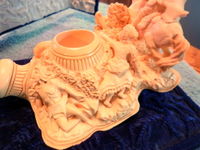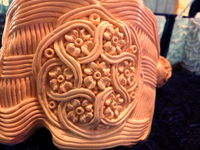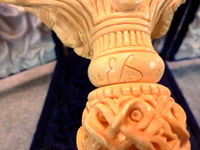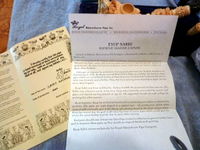Eyup Sabri
Eyup Sabri's beautifully carved meerschaum pipes are highly prized by collectors, and many of them consider his work at the very top of this unique and compelling genre. And yet it is difficult to find enough information to present a compelling bio of his life and work.
Eyrup died May 16, 2005, but left the World a compelling body of work to remember him by while appreciating his artistry. Hopefully we can flush out more of the details of his life, especially those that would give us a better glimpse into his mentors, inspirations, and daily routines that facilitated his amazing pipes.
Here are two beautiful examples of Sabri's artistry with descriptions, courtesy SmokingPipes.com:
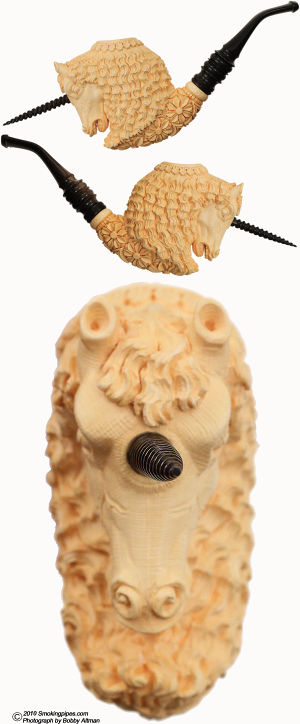
Unicorn on the left:
Adroitly carved, and featuring both an astonishing detail, as well as a delrin tenon and mortise insert, something astonishing advanced, given the date of production. Then again, Eyup Sabri was always well to the right of the Bell curve in his art. The late Mr. Sabri is held by many a savvy meerschaum collector as amongst the greatest carvers to have ever worked with the material, and is cited as a mentor or influence by many of the best carvers in the business today. The quality of the carving on this piece is astounding, even taking into consideration the carver, and the detail work that appears in the Unicorn's mane, and supporting floral work, almost beggars belief. That Unicorn horn is actually horn, and so is it that wonderful stem.
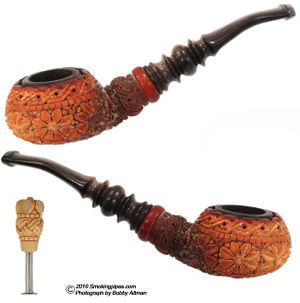
Beautifully colored Carved Tomato on the right:
What happens when the acme of meerschaum carving meets with perfection of coloring process? Well, it looks pretty much like the pipe that is on your monitor right now. I can't recall having seen a pipe carved by this late legend that didn't have a horn bit. If this "finishing touch" seems a bit extravagant on paper, it is exquisitely appropriate in person...Eyup Sabri wouldn't consider selling a particular piece, unless it represented the apogee of this singular, three dimensional art. At that point, sending it out with a lucite bit would be a bit akin to sending out Van Gogh's Sunflowers in a self-framing job from Michael's arts & crafts. There are meerschaums, and then there are MERRSCHAUMS, and then there is an Eyup Sabri. This pipe comes with original case and matching tamper.
- The following pipes were carved in 1986. They're numbered, and have Sabir's initials on the stem end. Courtesy, Carl
- These beautiful examples are from a private collection (all rights reserved):
The horse on the left is signed and dated 1999. It came with a full presentation case, plaque, and matching carved tamper, but did not come with papers. Sabri did a long series of unicorns that look exactly like this horse but have a single spiral, which is threaded so it can be unscrewed and stored for safekeeping (An example of Sabri's unicorn appears toward the top left of this article). The spiral on these unicorns was made from black water buffalo horn. This horse to the left is not just a unicorn with a missing spiral, however, as there is no threaded hole made to receive it. It's a huge piece, weighing in at a hefty 148 grams.
In the grouping on the right, uppermost are two signed and dated Sabris. The straight billiard on the left of the grouping has a horn stem pierced with an arabesque accented band around the top of the bowl. It has a slotted (double-wall) rim that allows light from above to shine through the pinhole piercings. It is signed and dated 1998, but came without a tamper or papers. At right in this grouping is a tiny arabesque pot, which is signed and dated 1998.
The Sabri arabesque and signature bold flowers, 1/2 bent pot to the left is in a blue presentation case with a white lid. The white lid suggests the pipe is circa 1984 -85). It is also a "ring" (a la Sevket Gezer, who carved along side of Sabri at the time). That arabesque or "Celtic knot band around the upper part of the bowl is actually detached from the bowl itself, and rotates smoothly over sloping channels of bundled papyrus reeds while at the same time being retained securely against separation from the bowl by overhanging and under-slung ledges. This "concentric, pinched-at-the-waist-bundles of reeds" is echoed in the shank and crown treatments. While very large, the pipe only weighs 49.2 grams.
- A beautiful example purchased by Bill Littell USCG MKCS Ret. in 1984 while stationed just west of Istanbul
Note: If you have any information to make this a more compelling article, please add it here, or send it to sethile.pipes@gmail.com, and I'll add it for you. --sethile (talk) 10:51, 14 June 2015 (CDT)
